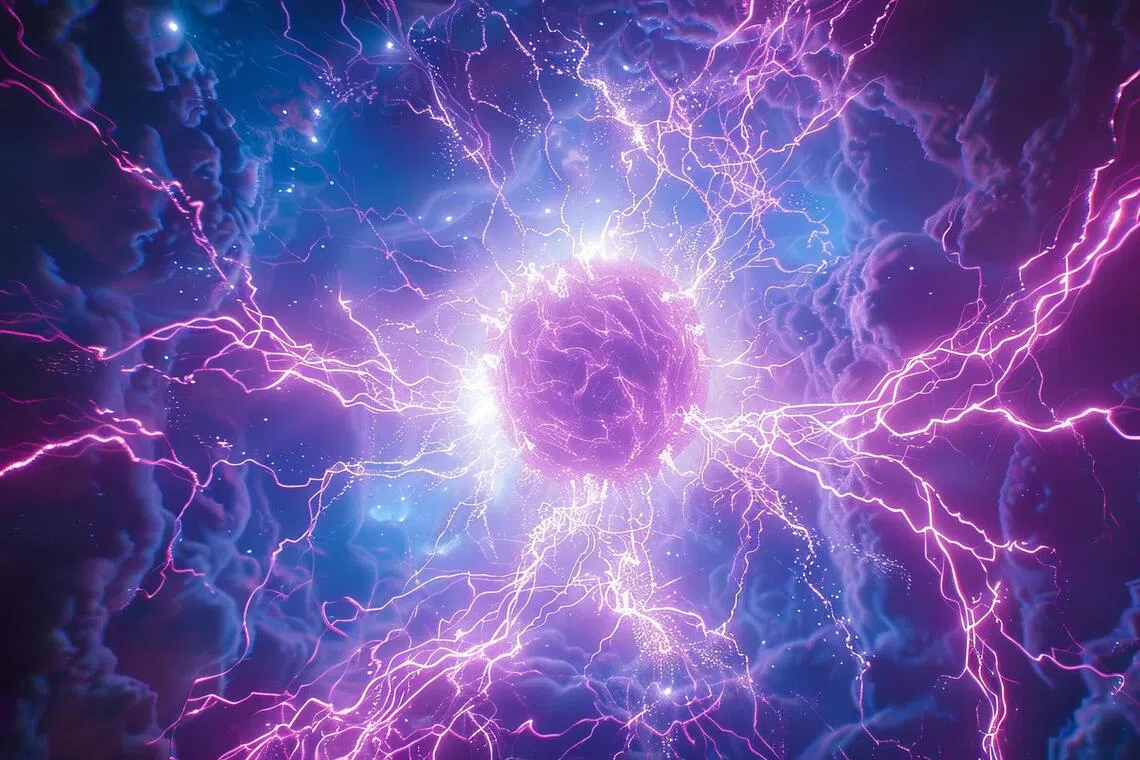askST: Ball lightning - what we know about this rare weather phenomenon
Sign up now: Get ST's newsletters delivered to your inbox

Ball lightning is a rare phenomenon where bright spheres of lightning form amidst a thunderstorm.
PHOTO: ADOBE STOCK
Follow topic:
SINGAPORE - Videos of a mystifying purple orb of lightning at various locations in Singapore surfaced on social media last week, and took the internet by storm.
Many netizens flocked to the comments section to debate the origin of the sphere, with some attributing it to a little-known weather phenomenon called ball lightning, while others claimed it was an AI-generated work of art.
On Sept 22, Singaporean fintech company YouTrip acknowledged on TikTok that it was the owner of the viral videos,
But before the big reveal, many Singaporeans had put on their sleuthing hats to theorise if ball lightning could indeed form in the Republic’s climate.
The Straits Times spoke to two climate scientists - Professor Steve Yim, the director of Centre for Climate Change and Environmental Health at Nanyang Technological University, and Adjunct Associate Professor Koh Tieh Yong from the Department of Physics at the National University of Singapore - to better understand the science behind ball lightning.
What is ball lightning?
It is a rare phenomenon where bright spheres of lightning form amidst a thunderstorm.
Has ball lightning been spotted in Singapore?
Prof Yim: Based on monitoring records from the Meteorological Service Singapore (MSS), there are currently no documented occurrences of ball lightning in Singapore.
How does ball lightning form?
Prof Koh: Thus far, two mechanisms have been investigated scientifically to separately explain ball lightning formation above water or land.
Above water
Lightning is a high-voltage electric current discharged from storm clouds. Water bodies dissolve a lot of salts and are natural electrolytes containing electrically charged ions.
Laboratory experiments discharging high-voltage electric currents above electrolytes have replicated ball-like formations of ionised gases known as plasmas. Excited ions in the plasma may spontaneously transition to stable states by emitting light energy, creating lab-created “ball lightning”.
Above land
Surface soil is a mixture of silicon-containing minerals that vaporise when subjected to intense heating from lightning strikes.
When scientists fire microwave beams at solid materials like silicon, glass, ceramics to simulate lightning, vaporised material puffs up as a buoyant ball-like web of nanoparticles. As these nanoparticles oxidise in air, energy stored is released as light and heat, thus generating “ball lightning”.
What don’t we know about ball lightning?
Prof Koh: Existing explanations still lack a mechanism that can maintain the stability of ball-like formations and sustain their horizontal motion across the air. Lab-based experiments also do not factor in environmental variables like wind, which can easily disrupt the organised spherical formations.
Does Singapore’s weather permit the formation of ball lightning?
Prof Koh: During the inter-monsoon periods and southwest monsoon season, Singapore often experiences intense thunderstorms, sometimes organised into line squalls. As the turbulent vertical air flow is vigorous in these storms, lightning discharge is commonplace.
According to the MSS, the Republic has one of the highest rates of lightning activity in the world, with an average of 167 thunderstorm days a year. This increases the chance of ball lightning formation albeit its occurrence is still very rare.
Prof Yim: Singapore experiences strong convective activity and abundant moisture, which are favourable conditions for lightning formation.
However, based on existing reports, ball lightning is more commonly observed over large open plains, such as in Oklahoma in the United States, where the environment may better support stable discharges.


